What Is a Pillar Page?
Pillar pages—also called pillar posts or content pillars—are pieces of content that serve as the cornerstone of a topic cluster—a group of pages created to establish a website’s authority on a specific subject.
They provide a comprehensive overview of a broad topic and link to related content pieces.
For example, let’s say you want to create a topic cluster on SEO.
Your pillar page could be a complete article covering SEO basics. Among other topics, you’d mention technical SEO, link building, and local SEO.
From your pillar page, you would add links to cluster pages. These would dive deeper into the subtopics mentioned on your pillar page.
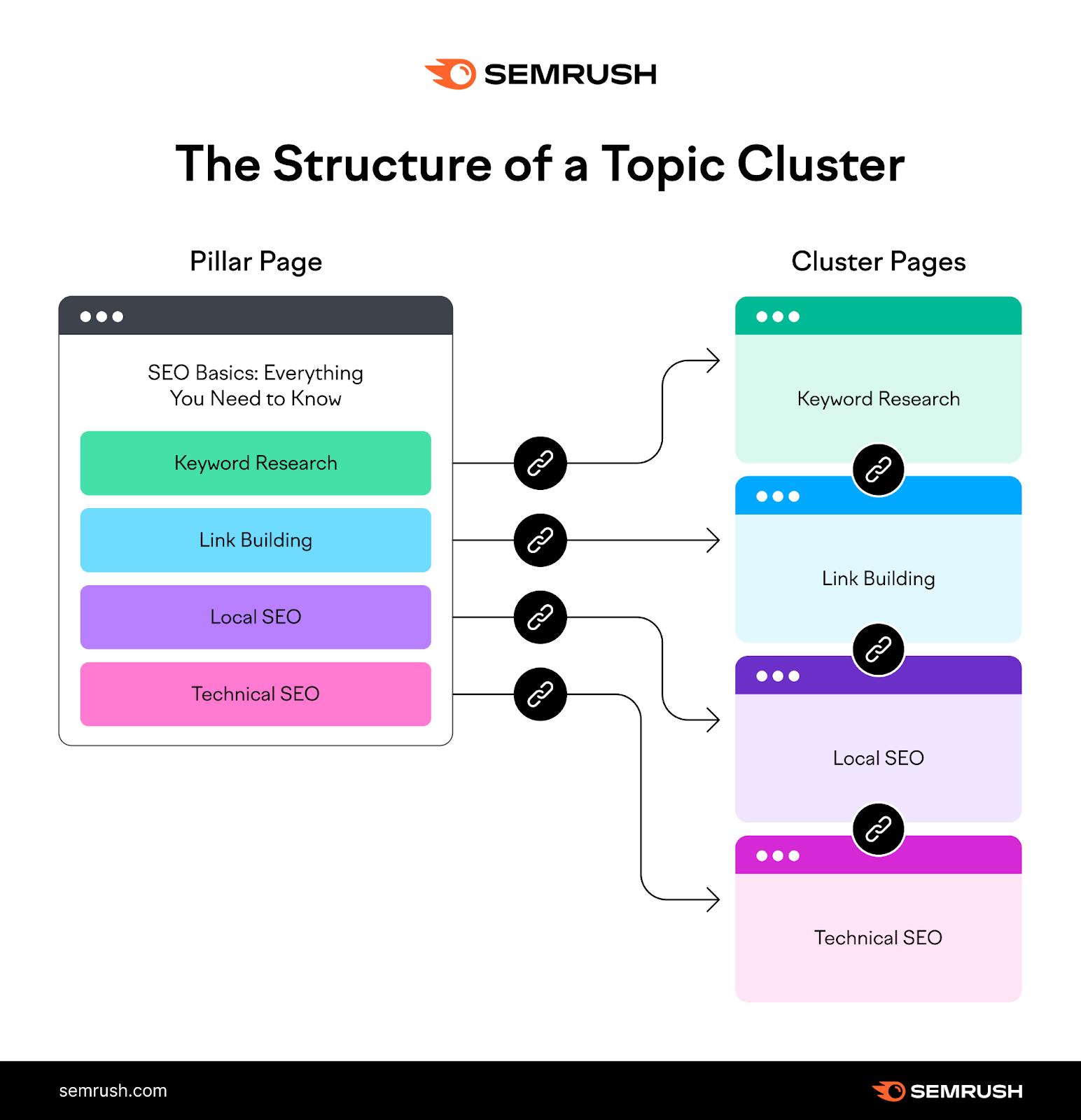
Your pillar page acts as a content hub. And guides users to more specific content pieces.
How Pillar Pages Can Help Your SEO
Pillar pages benefit your SEO rankings by helping you:
Build Topical Authority
Pillar pages aid in building topical authority by forcing you to comprehensively cover a topic. First, as an overview on the pillar page itself, and then in more detail on cluster pages.
As part of SEO, pillar pages and accompanying cluster content allow you to showcase your expertise and provide a clear signal to search engines that you’re an authority on the topic.
Simplify Navigation
Pillar pages help structure your content and make it easier for both visitors and search engines to navigate.
This helps visitors find the information they’re looking for more quickly. And improves the overall user experience (UX), which is something Google aims to reward.
Avoid Keyword Cannibalization
Structuring your content with pillar pages and topic clusters in mind can help you avoid keyword cannibalization—multiple website pages competing to rank for the same keyword.
Here’s how:
If you’re not using topic clusters, you’re likely creating content based on a list of keywords derived from keyword research. And some of the keywords from your list might have similar (or the same) search intent.
With pillar pages and topic clusters, you take a different approach and plan out your pages based on the information they need to include and the topics they need to cover. Instead of starting with keywords.
This helps you prevent keyword cannibalization because you can avoid getting into a situation where you’re creating two pages on the same topic.
Improve Your Internal Linking Structure
Planning out topic clusters and pillar pages requires you to be intentional about how your website pages will be connected.
If you do it right, the pillar page will link to all the pages within a topic cluster. And all the cluster pages will link to the pillar page. And some—if not all—of the cluster pages will link to each other.
This results in a more logical internal linking structure which is easier for search engines to understand.
Generate Backlinks
Since pillar pages are in-depth takes on a topic, they often attract more backlinks compared to less comprehensive pieces of content.
Pillar pages get shared more often. And they get cited more often, too. All of this results in more backlinks for the website.
How to Create a Pillar Page
To create a pillar page, follow these steps:
1. Brainstorm Topic Ideas
Start by thinking about which core topics are most relevant to your website and audience. For example, the following might be core topics for a fitness blog:
- Strength training
- Weight loss
- Fitness supplements
All three could be potential pillar pages.
Let’s take the first topic as an example. To create a pillar page on strength training, you’ll want to cover every aspect of it. Here are some potential subtopics you could cover on this pillar page:
- Benefits of strength training
- Strength training exercises
- Strength training equipment
- Advanced strength training techniques
All of the above, apart from being sections in your new pillar page, could also be standalone cluster pages.
Use the Topic Research tool to get ideas for what information to include on your pillar page. Here’s how:
Start by entering the topic of your pillar page. Then click “Get content ideas.”
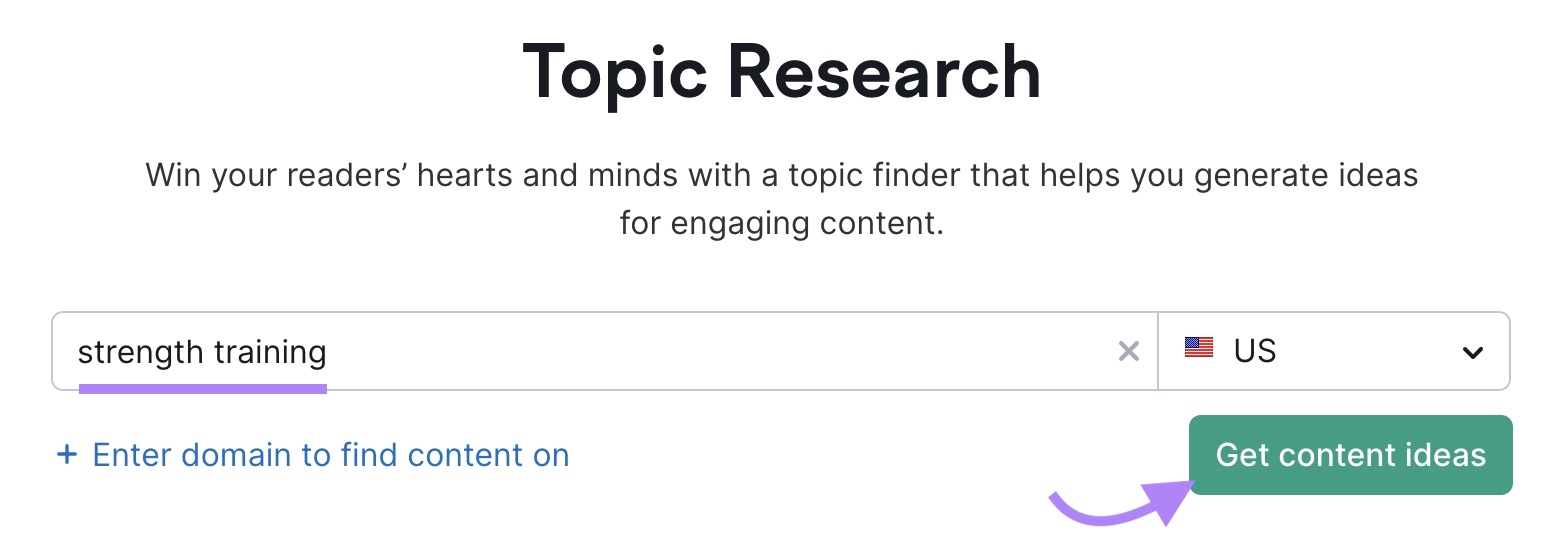
The tool will then generate a report. Here, you’ll be able to see a list of subtopics related to your core topic.
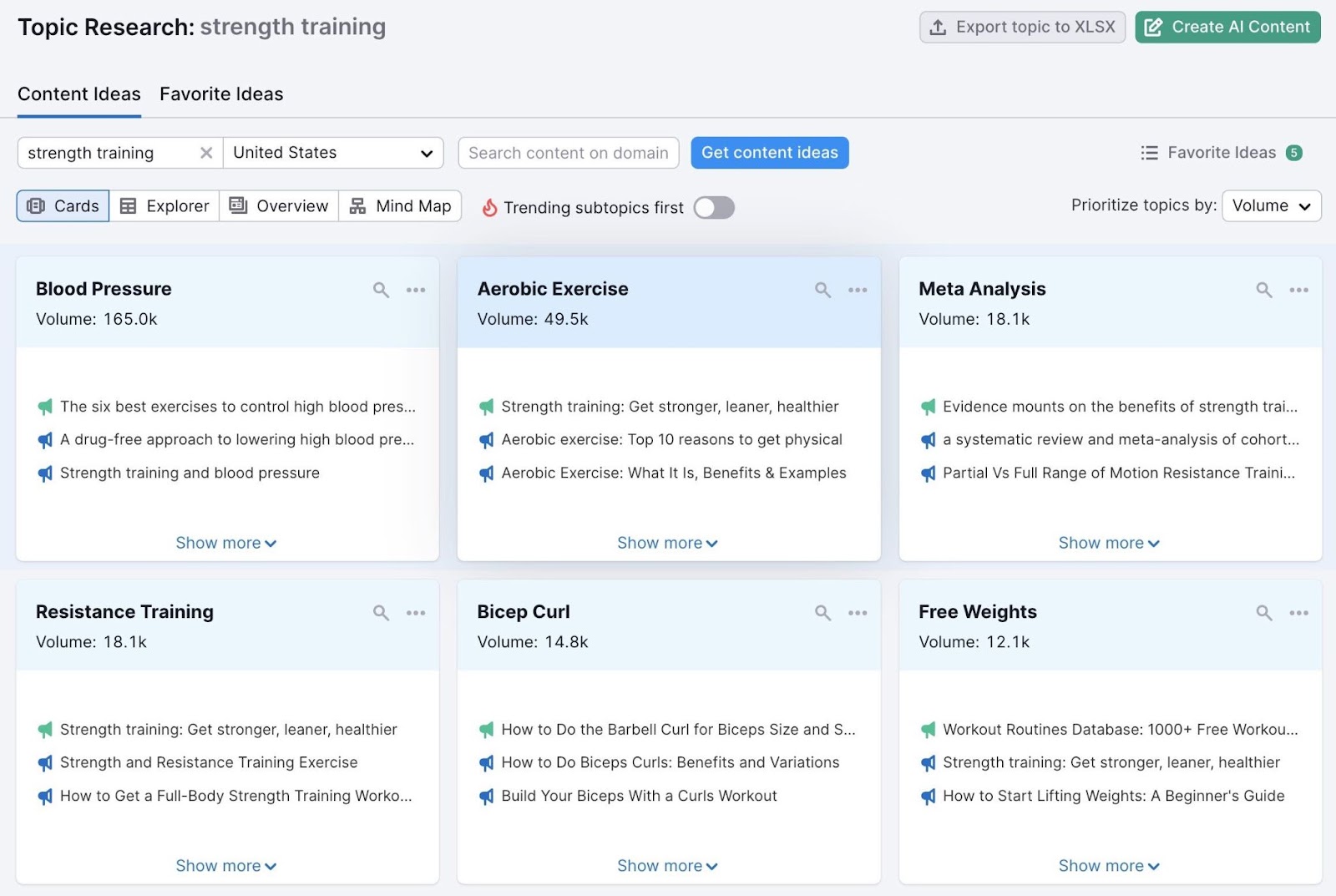
You can click on “Show more” at the bottom of each card to learn more about a particular subtopic.
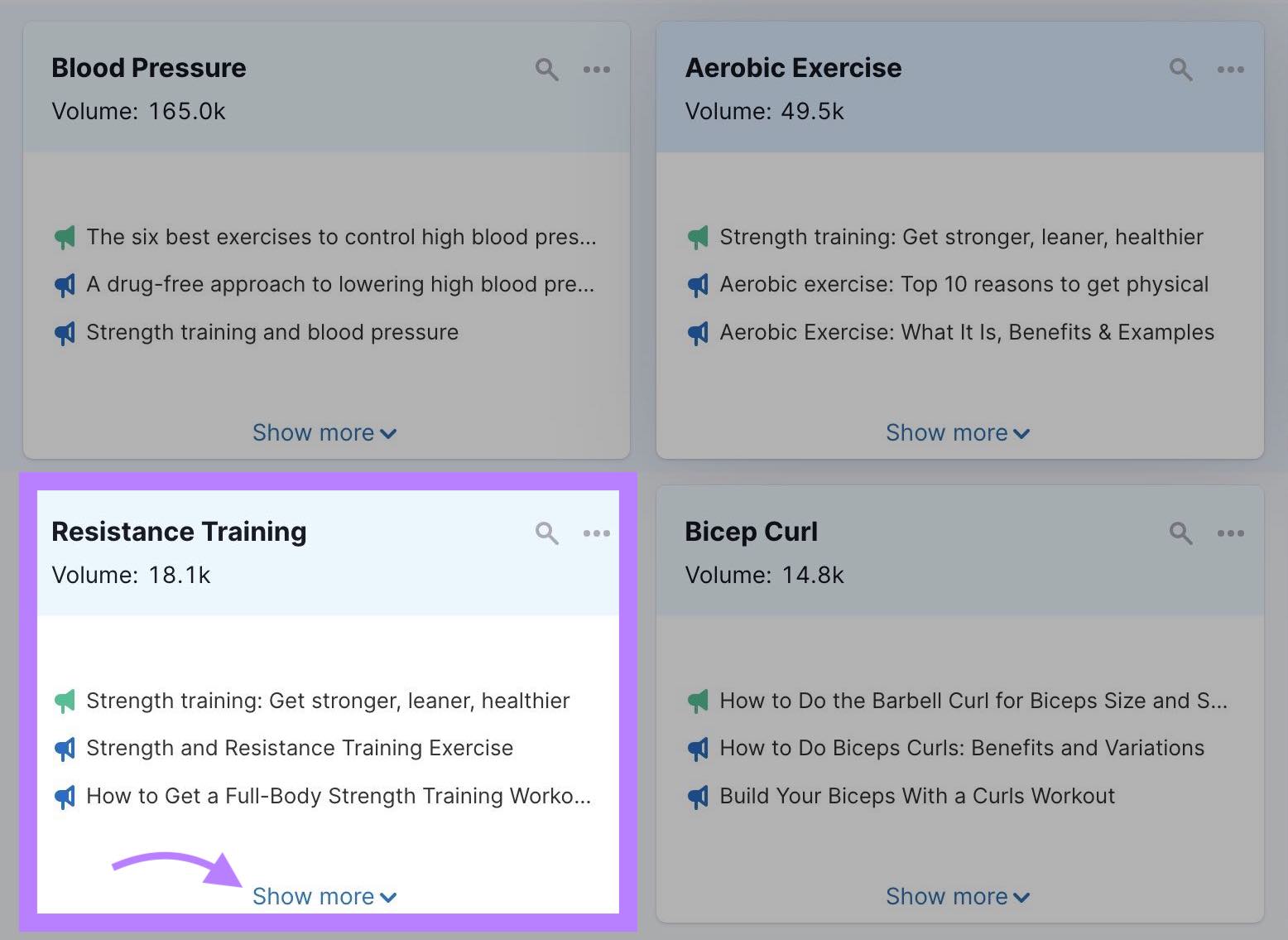
Here, you’ll be able to see:
- The total search volume for that subtopic
- How difficult it is to rank for related keywords
- Headlines used by pages covering that subtopic
- Commonly asked questions about the subtopic
- Related searches
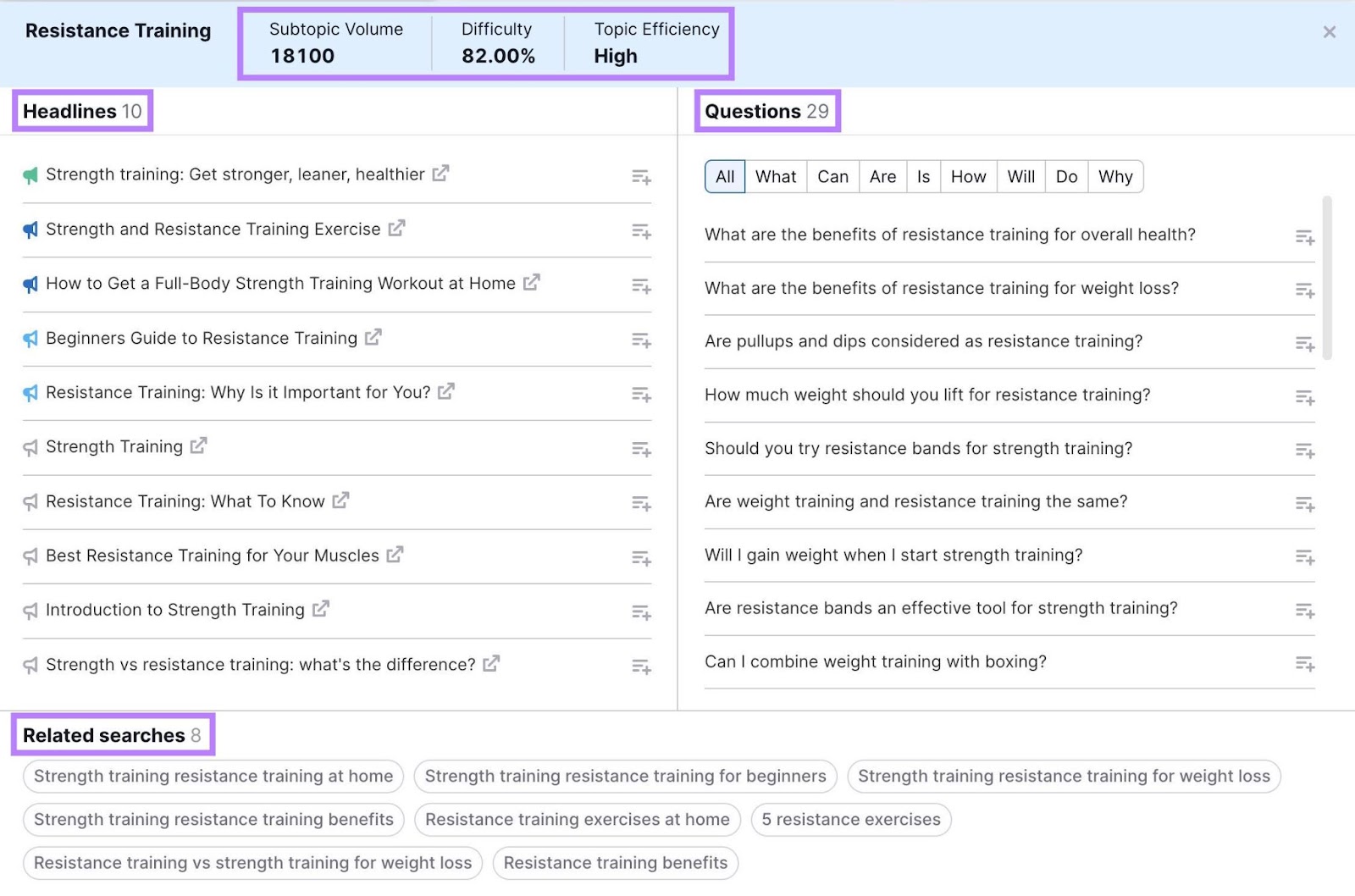
You can review this information for every individual subtopic. Or export all data for all subtopics by clicking the “Export topic to XLSX” button.
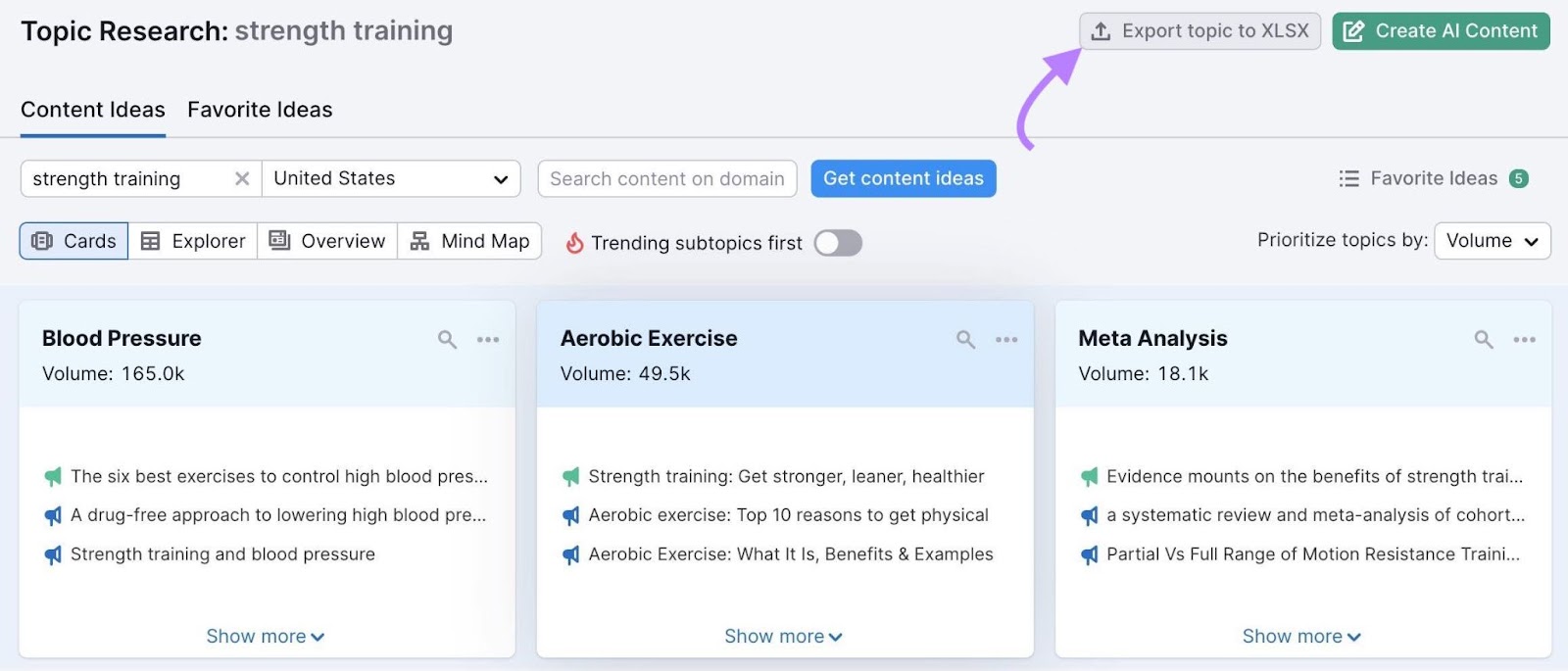
2. Organize Your Pillar Pages and Subtopics
Your website will have multiple pillar pages. And every pillar page will have multiple subtopics.Use Semrush’s Keyword Strategy Builder to organize everything. Here’s how:
Start by entering one or more seed keywords representing your website’s core topics and click “Create list.”
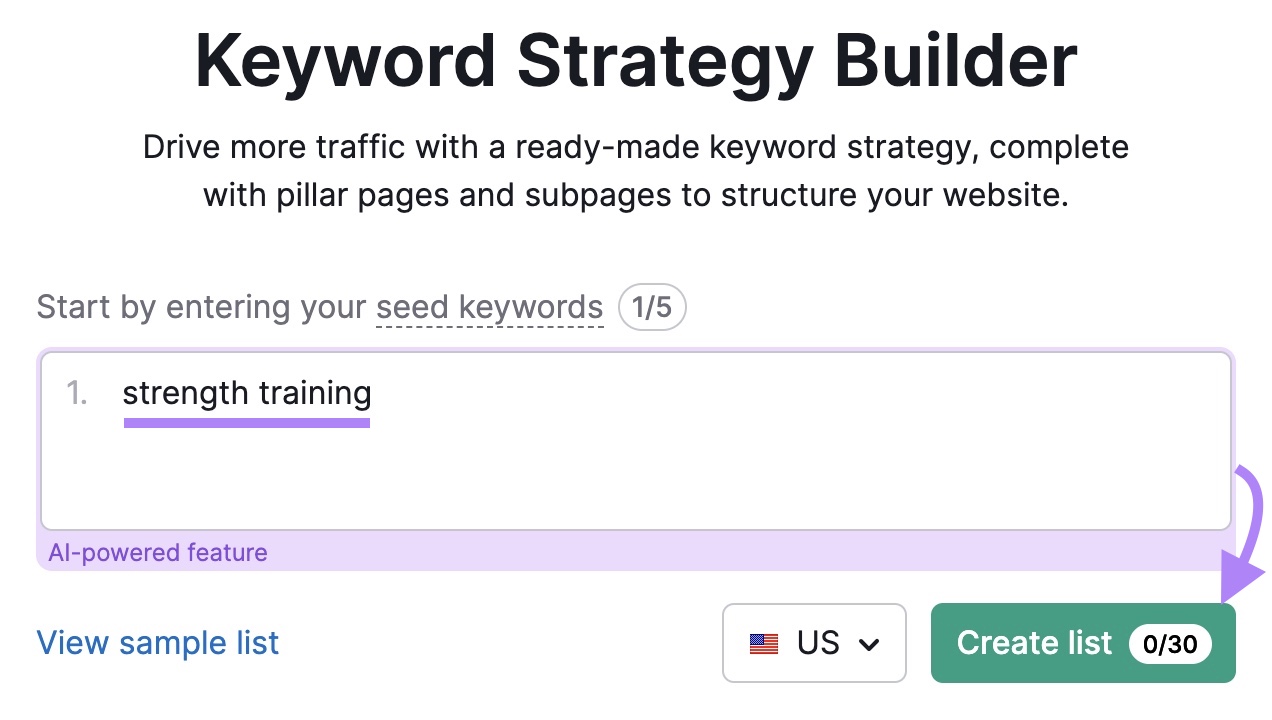
The tool will then generate a list of pillar page topics and their potential subpages.
You can see a visual overview of all the pillar pages and topic clusters in the “Topical Overview” section at the top.
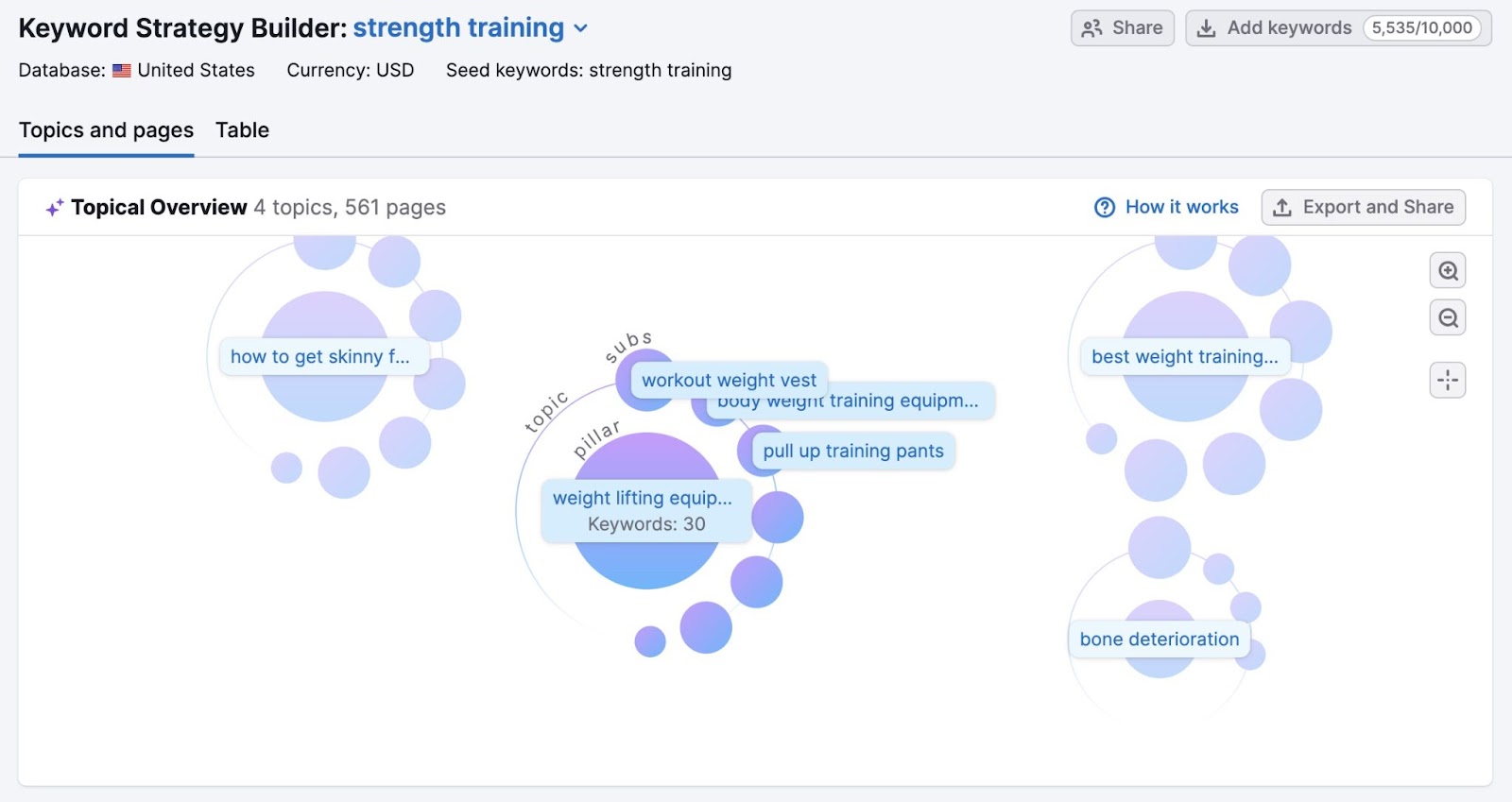
If you scroll down to the “Pages Details” section, you’ll see a list of pillar pages. Under each pillar page will be a list of subpages associated with it.
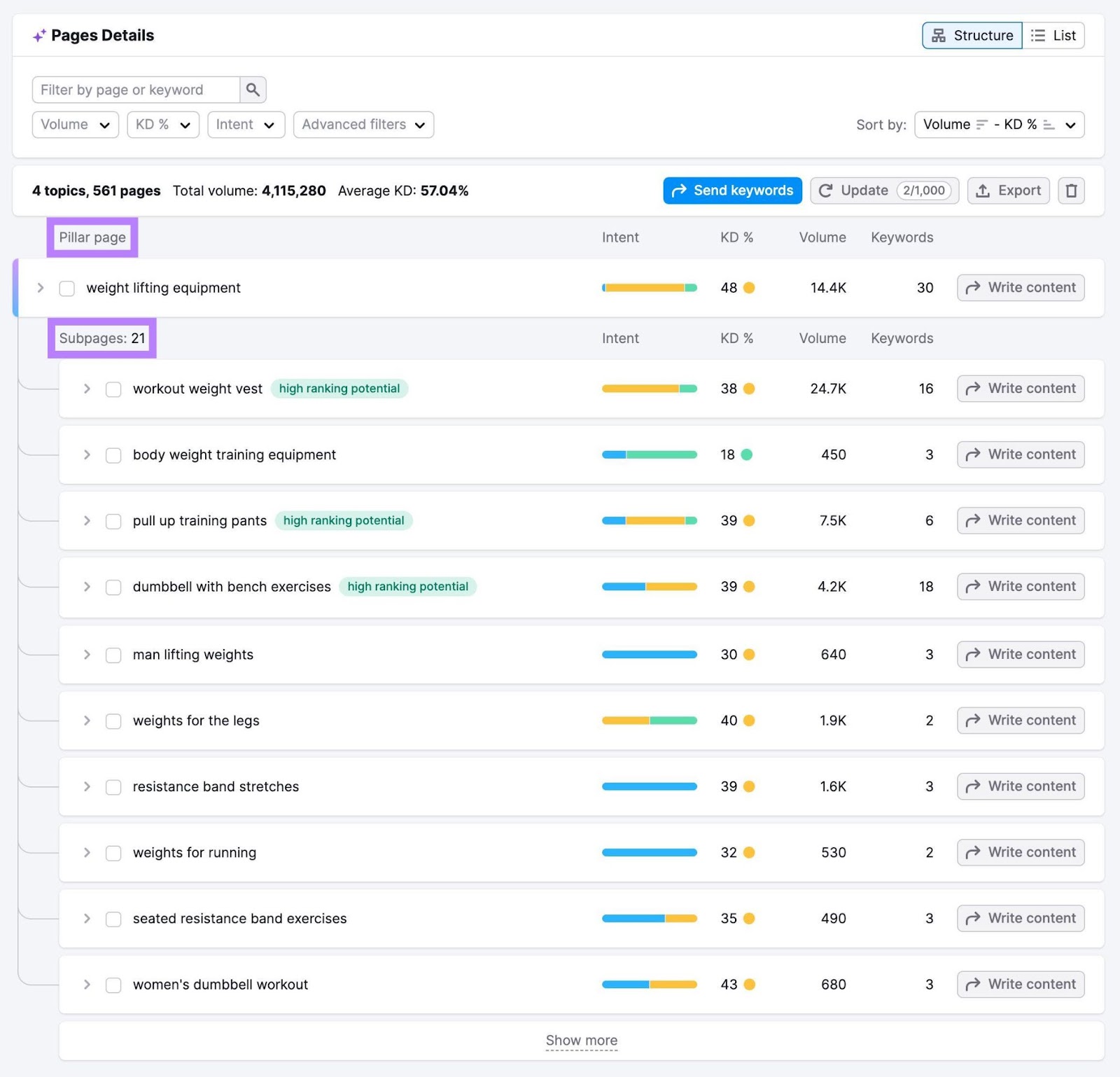
For each pillar page and subpage, you’ll be able to see:
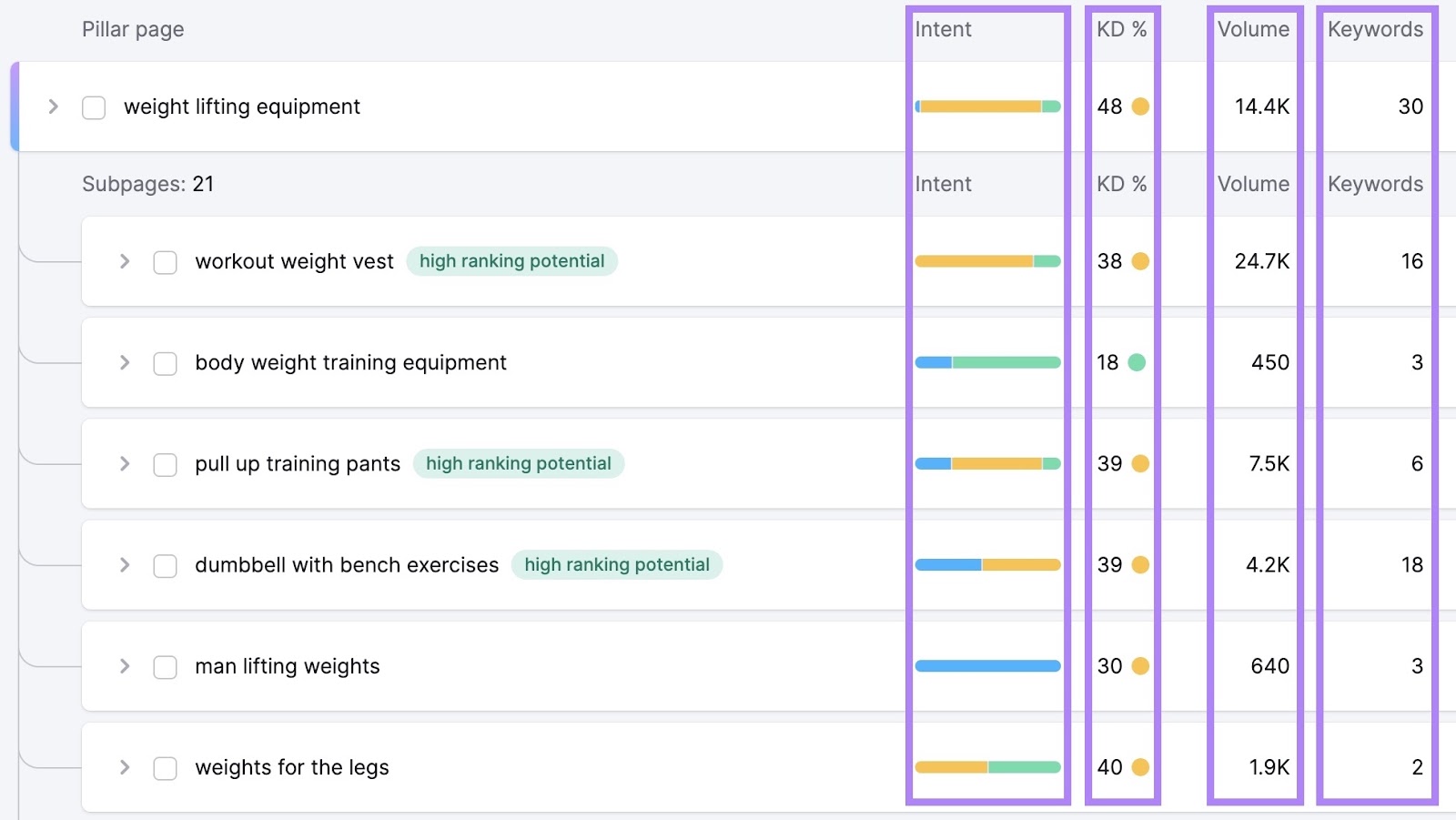
From here, you can select specific pillar pages and subpages you’d like to include in your content plan by clicking on the checkbox next to each page.
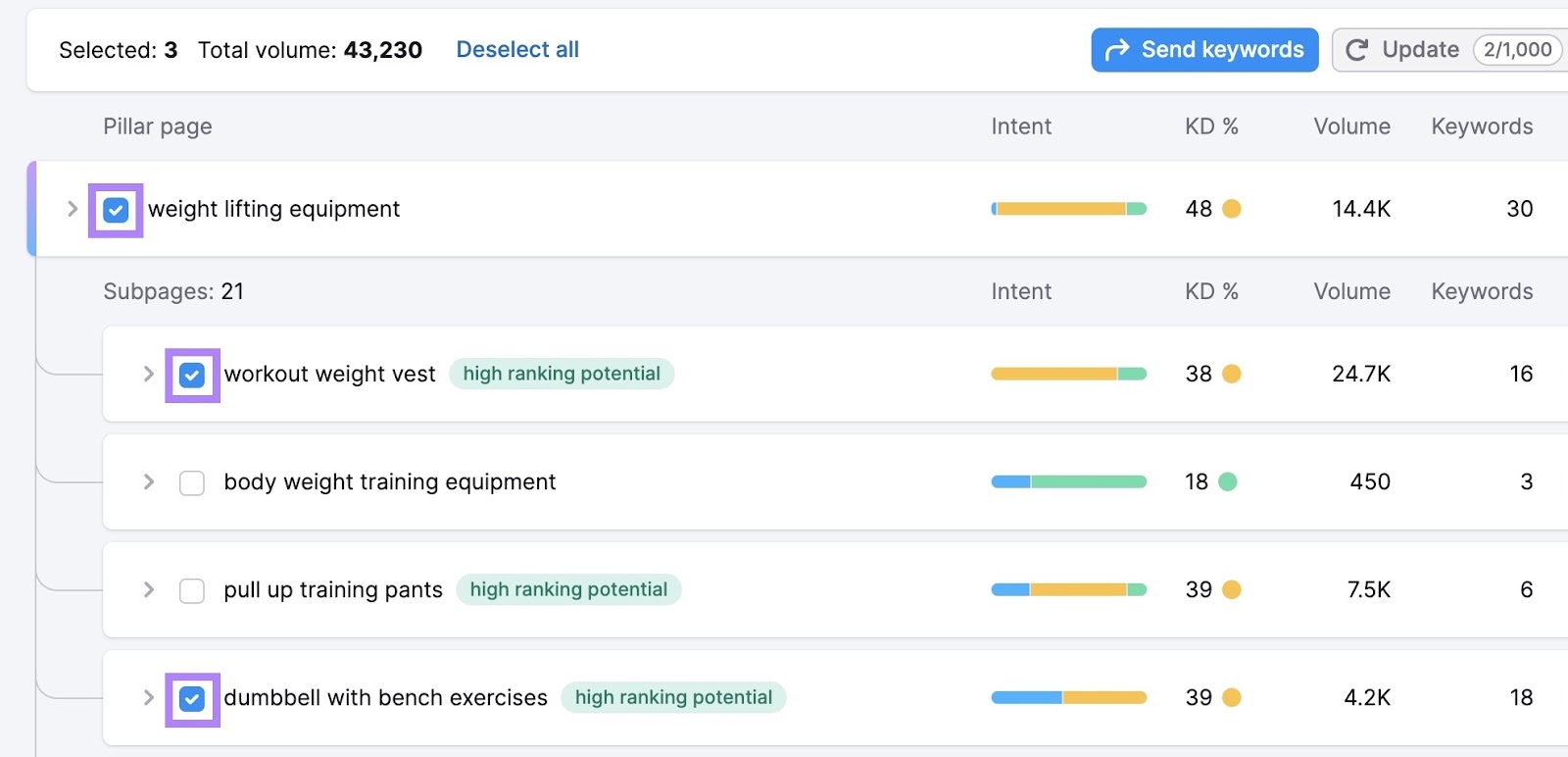
And then click “Send keywords,” select “Other keyword list,” and click “Apply.”
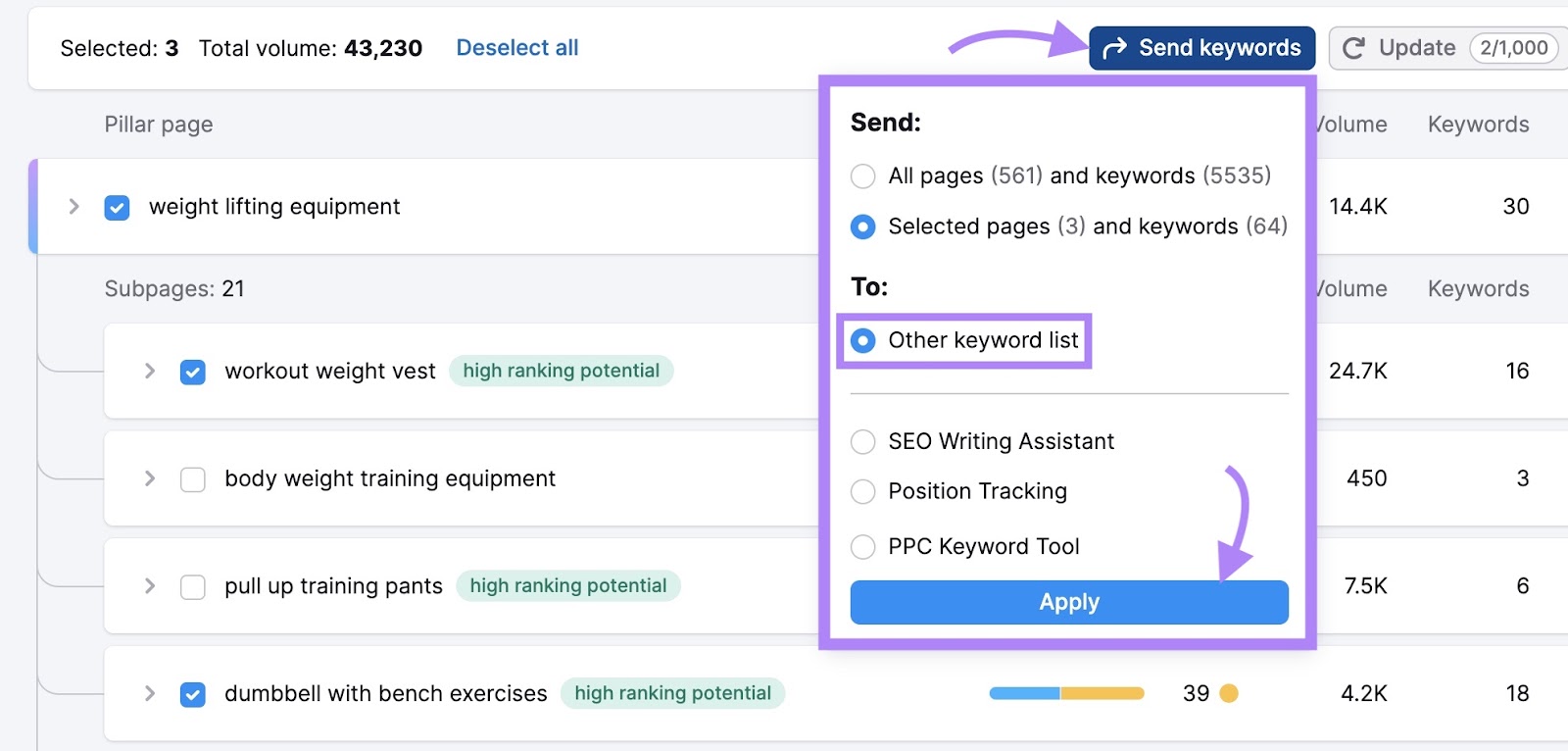
Next, from the drop-down box, select the keyword list to which you want to add the keywords. Or click on “Create new empty list” to create a new list.
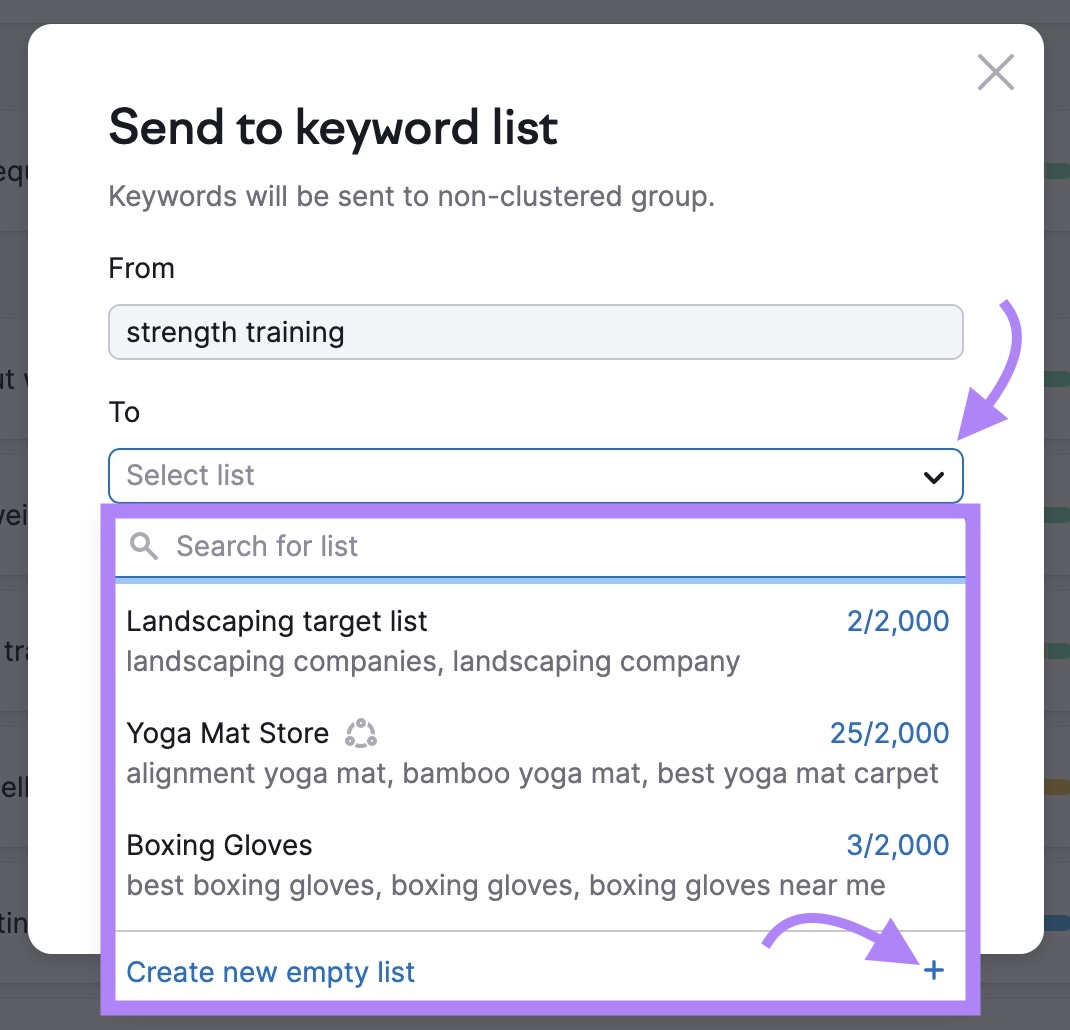
Choose whether you want to copy or move the keywords to the second list. Finally, click “Send keywords.”
Then click “Go to all lists” at the top of the page to see all your keyword lists.
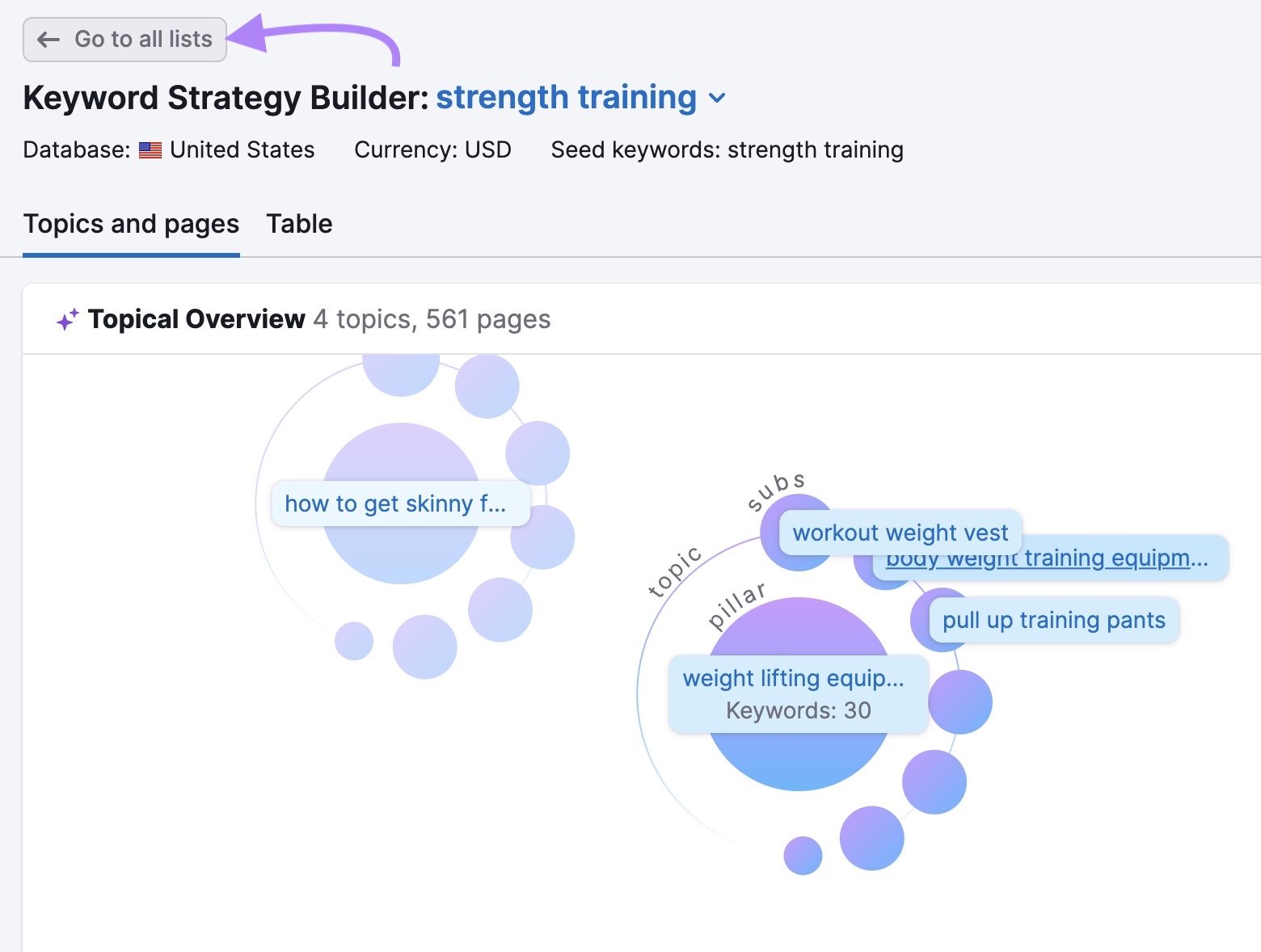
Click on the one you’ve just created to review a list of all the keywords associated with your pillar pages and subpages.

From here, you can export all the keywords by clicking the “Export” button.
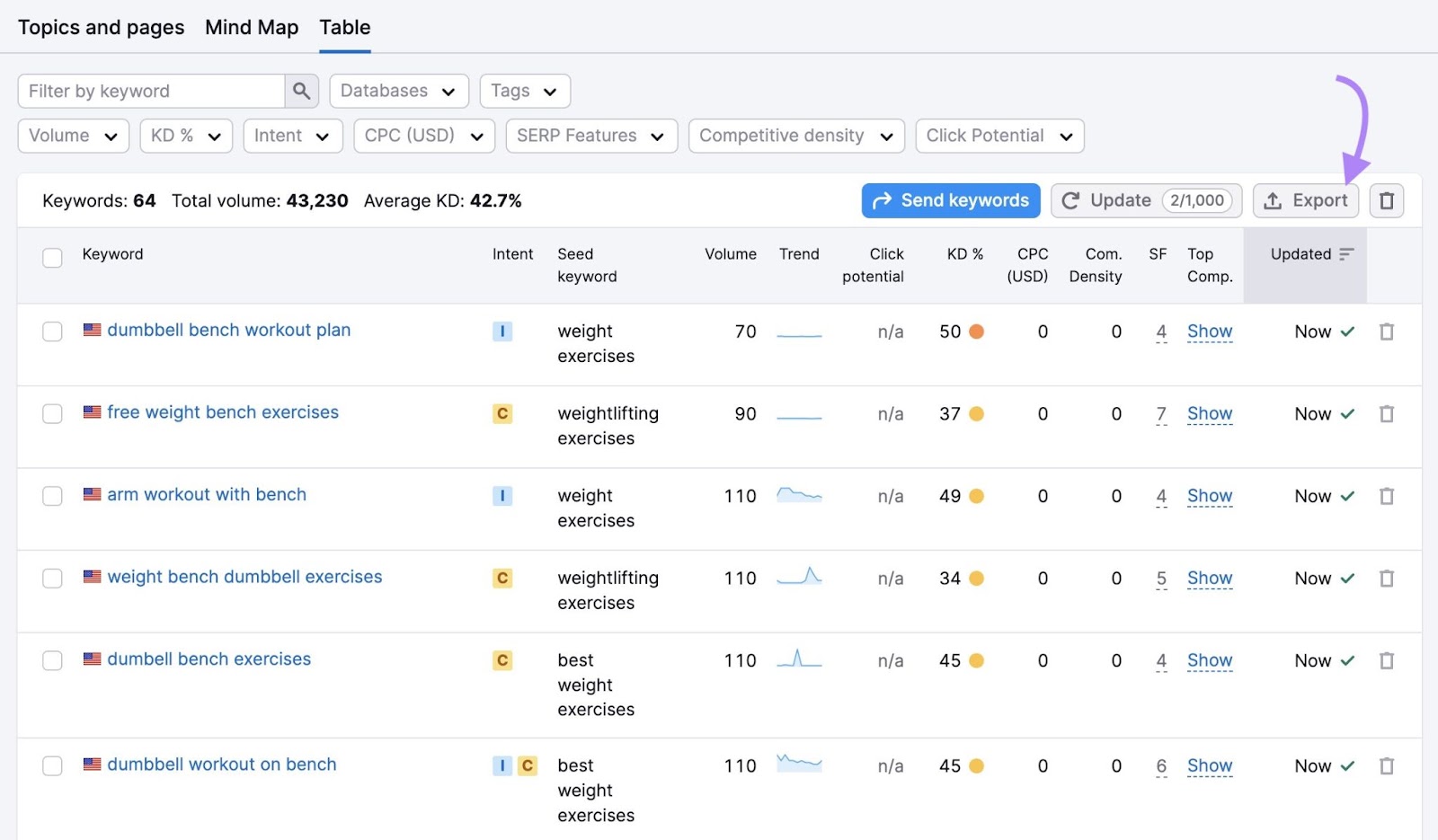
Use the list to start creating your pillar pages.
2. Create Your Content
Pillar posts are intended to holistically cover a topic and include internal links to cluster pages. Other than that, there isn’t a fixed set of rules to follow.
However, most great pillar pages share the following traits:
- They’re search engine optimized. Optimize your pillar page just like any other page. Check out this SEO writing guide to learn how.
- They’re evergreen. Evergreen content stays “fresh” longer. You don’t need to update it every month, or possibly even every year, depending on the topic and how the content performs.
- They’re easy to read. Pillar pages are content-heavy because they cover many aspects of a topic. Simplify navigation and amplify UX using elements like tables of contents, images, and bulleted lists.
- They incorporate different types of content. Most pillar posts are text-based. But you can also include other formats, such as videos or infographics.
- They include useful links. Pillar pages act as content hubs and often include many internal links. Only include relevant links with optimized anchor text.
- They use relevant CTAs. Use compelling calls to action (CTAs) to encourage users to perform an action, such as creating an account or downloading an ebook.
Dive deeper in the content creation process to learn how to create the best topic clusters.
3. Upload It to Your Site and Add Internal Links
You don’t have to create a custom design or make your pillar page look different from other pages on your site. Upload it like any other piece of content on your site.
If you haven’t done so already, add internal links.
Make sure the pillar page contains links to all the cluster pages. And that all the cluster pages link to the pillar page.
Ideally, you’ll want to use the primary keyword as the anchor text when linking to both the pillar page and the cluster pages. This will make it clear to search engines what each page is about.
If your cluster pages aren’t published and ready for internal links, you can publish your pillar post without them.
As you publish new cluster pages, edit your pillar post and add links to the recently created URLs.
This process is essential to building a logical website architecture.
Types of Pillar Pages (+ Examples)
Not all pillar posts are created for the same purpose. Below, we explore different types of pillar posts. And pillar page examples to inspire you.
Remember that the divisions between these categories are not absolute. Some pillar pages might have elements of each type.
1. The Guide Pillar Page
A guide pillar page is a comprehensive overview of a topic. It can be a 101 guide for beginners or an ultimate guide for advanced users, for example.
The following are good examples of guide pillar content:
Hunter’s Cold Email Guide
Hunter is an email outreach platform designed to help you find and connect with potential clients, business partners, and other people important to your business.
Hunter’s cold email guide is a great example of a pillar page that covers all the important aspects of a topic (in this case, cold email outreach).
It contains information on:
- Creating an outreach strategy
- Building a list of recipients
- Optimizing the technical aspects of email outreach
- Writing effective cold emails
- Scheduling and sending campaigns
- Analyzing the results of outreach campaigns
The above is everything you might need to get started with cold email outreach. This is why it’s no surprise that this particular pillar page ranks for more than 600 keywords.

The Complete Guide to Time Tracking by Hubstaff
Hubstaff is a time tracking and productivity monitoring tool for remote and field teams. Since time tracking is one of the most important topics for the company, they decided to create a comprehensive pillar page on the topic.
It covers everything you might want to know about time tracking, including:
- The benefits of time tracking
- Time tracking methods
- How to choose time tracking software
- How to use time tracking data to improve performance
- How to get employee buy-in for implementing time tracking
2. The What-Is Pillar Page
Users typically search for “What is + [topic]” when looking for information. A what-is pillar page responds to those search queries.
Below are two examples of solid what-is pillar pages:
What Is Dropshipping and How Does It Work by Shopify
For an e-commerce platform like Shopify, talking about fulfillment models, such as dropshipping, makes a lot of sense. That’s why the company created a detailed pillar page on the topic.
It includes:
- What dropshipping is
- How it works
- Who it’s for
- Its benefits and drawbacks
- Frequently asked questions
At the moment, this pillar page ranks for 1,600 keywords and drives an average of nearly 58,000 visits every month.

What Is Artificial General Intelligence by Zapier
Zapier is a popular automation solution that integrates with thousands of apps.
The company is fully supportive of AI and has implemented several AI features into its platform. Along with this, they write about various AI topics on their blog. And one of their pillar pages provides an in-depth overview of artificial general intelligence (AGI).
It covers all the important aspects of the topic, including:
- What AGI is and how it works
- The difference between AGI and artificial narrow intelligence (ANI)
- Types of ANI, such as chatbots, large language models, and voice assistants
- An estimate of when true AGI will be developed
As of this writing, this particular pillar page ranks for more than 140 keywords.

3. The How-To Pillar Page
How-to pillar pages help your readers solve problems, often with step-by-step tutorials.
Some examples of how-to pillar pages include the following:
How to Start an Online Store by Shopify
Another excellent pillar page from Shopify. This one details everything you need to know about opening an online store.
It includes information on:
- Deciding on a target audience
- Finding a business idea and choosing products
- Choosing an ecommerce platform
- Designing a brand
- Determining the business structure
- Setting up an ecommerce website
- Launching and marketing an online store
The page ranks for 1,600 keywords and drives more than 18,000 organic visits every month.

How to Use LinkedIn for Business by Buffer
Buffer offers social media management software that helps businesses manage their social media presence across a variety of platforms, including LinkedIn.
One of their pillar pages is an extensive guide to using LinkedIn for business, which covers topics such as:
- How to create a company page on LinkedIn
- How to optimize your LinkedIn presence
- How to get more LinkedIn followers
- The best types of content to post on LinkedIn
The page currently ranks for more than 250 keywords.

Create Stronger Pillar Pages
Pillar pages can become a foundation of your content strategy if you follow these tips to build them well.
Use Semrush’s Keyword Strategy Builder to create a keyword strategy for your website based around relevant pillar pages and topic clusters in minutes.



